Sustaining the Investigator Pool: Understanding Operational Burden and Implementing Valuable Supportive Solutions
The sharp rise in ongoing clinical research studies is driving demand for greater participation in research by physicians as well as by patients.
The sharp rise in ongoing clinical research studies is driving demand for greater participation in research by physicians as well as by patients.1 However, numbers of principal investigators filing the Food and Drug Administration (FDA) Form 1572 fell globally from 27,861 in 2008 to 23,935 in 2009 and 22,243 in 2010.2 In addition, within the pool of investigators who have filed a 1572, turnover rates are high, with 35% of investigators in the U.S. not returning to conduct another clinical trial by 2014 since initially submitting a 1572 in 2006.3 The corresponding figures are even higher outside of the U.S.: 55% for Canada, 53% for South America, 53% for Asia Pacific, and 47% for Africa (see Figure 1).3 The impact of this high investigator turnover in industry-sponsored clinical trials is significant, contributing to escalating costs for site selection, qualification, training, and start-up.
Figure 1 Investigator Turnover by Region
In parallel to pursuing strategies for attracting and training new investigators to clinical research, it is also vital to obtain a better understanding of why investigators stop doing research after only one clinical trial, and to explore options for addressing these issues. A review of the literature suggests that barriers may be system or organization-related as well as trial and physician-related.1,4,5 System and organization-related barriers include time involvement (e.g., research-related work, discussions with patients, grant applications and ethics submissions) and resource issues (e.g., costs involved in research participation, facilities and infrastructure, and requirements of sponsors).1 Trial-related barriers include lack of clinical or scientific rationale for the research, increasing complexity of trials, excessive trial costs not covered by the trial sponsor, and inferior trial medications compared to standard therapy. Physician-related barriers include lack of interest in the research topic, limited familiarity with research procedures, lack of allied support staff, and disruption to clinical practice.
While some of these barriers are immovable (e.g., ethics submissions), many of the system, organization, and physician-related barriers are under the control of the research sponsor and its contract research organization (CRO) partners. In order to help the industry identify solutions to decrease the high investigator turnover rates, we conducted a global survey to solicit actionable feedback from investigators on the burden associated with participating in clinical trials.
Methods: Global survey of 750 investigators
To better understand the burden placed on investigators by clinical operations and the potential value of supporting solutions, DrugDev surveyed 750 clinical trial investigators from its Global Network in seven countries (Argentina, Australia, Germany, India, South Africa, the UK, and the U.S.). An invitation to participate in the 25-question online survey was emailed to approximately 11,000 randomly selected investigators. The survey was open from Oct. 28 to Dec. 3, 2013. Respondents were offered the chance to win one of five iPads.
Respondents rated the questions on investigator burden and supporting solution value on a five-point Likert scale: extremely burdensome/valuable; very burdensome/valuable; somewhat burdensome/valuable; a little burdensome/valuable; and not at all burdensome/valuable. Questions were scored based on the sum of the top two categories: extremely and very burdensome/valuable.
We examined the data for variation by country of origin using the Cochran Mantel-Haenszel statistic for categorical ordinal variables. The U.S. was used as the reference country. In addition, we looked for variation based on previous research experience as measured by the investigator-reported number of previous studies (two or fewer studies, three to 10 studies, and more than 10 studies), also using the Cochran Mantel-Haenszel statistic, with investigators who had conducted more than 10 studies as the reference group.
Results: Sample characteristics
The target sample for this group was 750 completed responses, weighted to the U.S. to reflect global investigator distribution.3 Emails were sent out to achieve the sample size, and as soon as these targets were achieved the survey was closed. Anyone responding after that time was not included in the analysis. A total of 750 investigators responded, with nearly half (45.9%) of the total responses coming from the U.S. An overall response rate of 7% was achieved (750/11,000), ranging from a low of 4% for Germany to a high of 14% for Argentina (see Table 1).
Table 1: Sample Characteristics
As seen in Table 1, 8.1% of respondents reported that they had participated in two or fewer trials, 37.7% participated in three to 10 trials, and 54.1% participated in more than 10 trials. Most reported having experience in more than one therapy area (an average of 3.5 per investigator), including cardiovascular (26.8%), internal medicine (25.3%), endocrinology/diabetes (24.9%), and pulmonary/respiratory (20.9%).
Results: Investigator reported burden
As shown in Figure 2, completing contractual and regulatory documents was the most burdensome administrative activity for investigators (46% rated this as very or extremely burdensome), with getting paid on time rated as the second most burdensome issue (36% found this issue very or extremely burdensome). Other factors identified as very or extremely burdensome included recruiting patients (32%), budgeting for clinical trials (32%), completing feasibility surveys (31%), and reporting serious adverse events (SAEs, 30%).
Figure 2: Level of Burden Associated with Clinical Trial Operations
Table 2 summarizes differences seen at the country level and by experience level. There was significant variation by country in six of the factors, with the largest differences seen between investigators in Argentina and the U.S.: reporting SAEs, completing site information forms, working with ethics committees, interacting with remote site monitors, and tracking clinical trial supplies. With the exception of patient recruitment, investigators in other countries rated these factors as being more burdensome than those based in the U.S. For patient recruitment, however, significantly fewer investigators in Argentina (p=0.0008) and India (p=0.0011) found this activity to be extremely burdensome.
Table 2: Variation in Burden Ratings by Country and Experience
With respect to clinical trial experience, seven items were significantly more burdensome for less experienced investigators who had completed two or fewer studies as compared to the most experienced with more than 10 studies: completing contracts and regulatory documents; budgeting for clinical trials; working with ethics committees; interacting with remote site monitors; retaining patients; tracking clinical supplies; and interacting with on-site monitors. Retaining patients in the study was also significantly more burdensome for investigators with three to 10 studies when compared to the group with more than 10 studies.
In contrast, one item, getting paid on time, was rated as more burdensome by experienced investigators, with 44% of those who had completed more than 10 studies finding this extremely or very burdensome, compared with only 16% of those who had completed zero to two studies.
Results: Value of supportive solutions
When asked what support functions would be helpful, more than 70% of global investigators indicated that the following five approaches would be extremely or very valuable (see Figure 3):
- Completing good clinical practice (GCP) training once every two years only, and uploading the training certificate to a central website accessible to multiple study sponsors (85%)
- Uploading CVs to a central website accessible by multiple sponsors, reducing document collection on study start-up (79%)
- Guaranteed investigator payment within 30 days (78%)
- Annual Master Service Agreement (MSA) with cross-pharma repository of essential documents (75%)
- Cross-sponsor sharing of contractual preferences (73%)
Figure 3: Value of Supporting Solutions
Table 3 shows that there are two primary areas of variation at the country level: patient recruitment and patient retention. Both of these were rated as less valuable among respondents in several countries when compared to those in the U.S. In addition, access to contract clinical trial support staff was viewed as being significantly more valuable in Argentina, Australia, India, and the UK.
Table 3: Variation in Value Ratings by Country and Experience
The value of activities associated with clinical trial support also showed some variability based on the level of investigator experience (Table 3). In particular, there was a statistically significant difference between investigators who had carried out zero to two studies compared to those with 10 studies for the response of guaranteed payment within 30 days. Investigators with zero to two clinical studies placed less value on this factor, with 67% of investigators rating this very or extremely valuable, compared to 83% of investigators who have completed more than 10 studies.
In addition to guaranteed payment within 30 days, more experienced investigators (both three to 10 and more than 10 studies) also rated the ability to upload their CV to a cross-sponsor website as significantly more valuable than less experienced investigators. In contrast, access to contract clinical trial support staff was rated as more valuable by investigators with fewer than two and three to 10 studies. Provision of patient retention emails/texts was rated as more important by investigators with three to 10 studies as compared to zero to two or more than 10 trials.
Limitations
Although these findings have important implications for how to decrease the burden of clinical trial operations, the study does have some limitations. First, the study was conducted among a sample of investigators who are members of the DrugDev Network and it is possible that the characteristics of the population could have influenced the results. For example, enrollment in DrugDev may self-select for investigators who are more comfortable accessing and sharing information online. However, given that online and mobile communications are standard practice today (86% of clinicians now report use of smartphones in their professional activities6), it is unlikely that this had a significant impact on results.
While the response rate seen in this survey was similar to those reported for online surveys in other publications,7 another limitation of the study design is the potential for non-response bias. Despite the fact that the proportion of non-responders was high in this study, the results are consistent with comments made by industry experts who have suggested study start-up and ethics as large sources of burden for investigators as well as a trend towards higher protocol complexity posing challenges to patient recruitment.
An additional limitation to this survey is that the investigators could only answer the questions put in front of them, and, therefore, were commenting on the burdens and solutions presented as options. To address this limitation, we also included open-ended questions in both the burden and solution section of the survey to try to identify issues that were not highlighted in the survey. Post-survey analyses of these open-ended questions did not identify any additional factors that were consistently raised by investigators.
Finally, while there was no significant difference in level of experience of investigators across all countries, there were differences between the U.S. and Argentina and India. In both cases, the U.S. had a greater proportion of investigators with more than 10 studies (58% for the U.S. as compared to 40% in Argentina and 37% in India), driven primarily by differences in the three to 10 vs. more than 10 study groups.
Discussion
According to analyses conducted by CenterWatch, the Tufts Center for the Study of Drug Development, and others using FDA 1572 data, the investigator landscape has shifted in ways that challenge successful conduct of clinical trials (e.g., lower proportion of experienced sites; high turnover among new PIs). The resulting impact for sponsors is higher operational costs, especially related to site identification, qualification, and start-up.
The purpose of this investigator survey was to better understand sources of investigator burden in clinical trial operations and to determine the value to investigators of potentially supportive solutions. Although the literature on investigator burden in clinical trials is limited, our findings appear to be consistent with expert comments.
As described above, completing contractual and regulatory documents was the most burdensome administrative activity for investigators, followed by getting paid on time. The level of burden for these two top-rated factors did not show significant variation at the country level. We did observe some variation in level of burden at the country level across six of the 13 factors tested, especially in Argentina. In general, nearly all of the differences were in system/organization-related factors and five of the six were rated as more burdensome outside of the U.S.
The one area of exception was patient recruitment, which was rated as significantly less burdensome in Argentina and India as compared to the U.S. We hypothesize that this finding may be related to differences in physician/patient relationships and access to medical care between countries. In Argentina, for example, the large concentration of population in the cities combined with a low rate of mobility encourages close relationships between patients and investigators, who can quickly identify appropriate patients from their practice and encourage them to learn more about clinical trials.8 The low barrier related to recruitment in India, however, may be more related to access, whereby patients enrolled in clinical trials are able to access free medical care, tests, and drugs, which they could potentially not afford otherwise.
As one might predict, there was a higher perceived level of burden for a number of activities reported by less experienced investigators compared to more experienced investigators, with seven of the 13 factors being reported as more burdensome by those having done zero to two studies compared to more than 10 studies. Again, the majority of these were system/organization related factors, where institutions, sponsors, or CROs could provide more support and resources to those early in their clinical research careers. An example of an area where provision of additional support to less experienced investigators could have a significant impact on start-up time, recruitment metrics, and ultimately investigator turnover is completion of contracts and regulatory documents.
Interestingly, getting paid on time was more burdensome to the most experienced investigators, compared to their less experienced colleagues. This, we believe, reflects the fact that investigators in the more than 10 studies category are more likely to rely on the revenue stream gained from payment from industry-sponsored studies for their business
Understanding the feedback on sources of burden, it is not surprising that the supportive activities that offered the most value to investigators were items that either guaranteed payment, or streamlined start-up such as GCP training, contracting, and essential document collection. Although there is no benchmark with which to compare, the level of value assigned to these activities was high in absolute terms (rated by more than 70% of the sample as extremely or very valuable).
Although this survey is among the first to quantitatively document the value of solutions to reduce investigator burden, including variation by country and level of experience, the findings are consistent with the opinion of industry experts.
Recognizing that system/organizational factors may be outside of the control of the research sponsor, several individual companies and industry organizations have begun to implement solutions to address trial-related sources of investigator burden. For example, TransCelerate BioPharma Inc., a non-profit organization of around 20 biopharmaceutical companies aimed at implementing innovation in clinical research, has created standards for minimum requirements for GCP training, CVs, and site qualification forms amongst other items.9 In addition, organizations such as the Investigator Databank-a global collaboration between Janssen, Eli Lilly, Merck, Pfizer, and Novartis-have launched online profiles where investigators can post non-protocol specific documents (e.g., CVs, GCP training certificates, site qualification forms) just once and have them accessed by all participating sponsors.10 A global network of research sites is also being established by the Alliance for Clinical Research Excellence and Safety (ACRES), with the aim of connecting research sites worldwide through a shared technology platform.11 The Global Health Network provides a number of different resources to support clinical trial conduct, including a Site Finder network, mostly centred on sites in Africa, Asia, and Latin America. The Society for Clinical Research Sites (SCRS) is a trade association established to represent global clinical research sites, and to support site sustainability.
In addition, a number of organizations are working to improve investigator training and accreditation, amongst them the Harvard Multi-Regional Clinical Trials Center (MCRT), the Association of Clinical Research Professionals (ACRP), and ACRES.
Moving beyond these initiatives for setting standards and sharing documents, additional opportunities for mutual benefit exist through standardizing confidential disclosure agreements (CDAs) and clinical trial agreement (CTA) clauses where possible; sharing of contractual preferences at the institutional level; and guaranteeing payment within 30 days.
Ultimately, if we are to reverse the trends of declining physician participation and high turnover in industry-sponsored clinical research, pharmaceutical company research sponsors (and their CRO partners) must be willing and able to change their processes to decrease the burden for clinical trial investigators.
Elisa Cascade, MBA, is Vice President, Corporate Development, DrugDev.org,elisa.cascade@drugdev.org; Claire Sears, PhD, is Project and Communications Director, Drug Dev.org, claire.sears@drugdev.org;Mark Nixon, PhD, is Director, Biostatistics, Chilli Consultancy, mark.nixon@chilliconsultancy.com
References
- S. Rahman et al. “Physician participation in clinical research and trials: Issues and approaches.” Advances in Medical Education and Practice 2011:2 85–93. http://www.academia.edu/914386/Physician_participation_in_clinical_research_and_trials_issues_and_approaches
- S. Redfearn. CenterWatch: “New data show number of principal investigators dropping 11% globally, and 20% in U.S.” April 25, 2011. http://www.centerwatch.com/news-online/article/1471/new-data-show-number-of-principal-investigators-dropping-11-globally-and-20-in-us#sthash.oLg4K7z5.dpbs
- K. Getz. “Characterizing the Global Investigative Site Landscape.” Presentation at the Drug Information Association 50th Annual Meeting (San Diego, June 15-19, 2014)
- Institute of Medicine (U.S.) Forum on Drug Discovery, Development, and Translation. Transforming Clinical Research in the United States: Challenges and Opportunities: Workshop Summary. Washington (DC): National Academies Press (US); 2010. 3, Challenges in Clinical Research. Available from: http://www.ncbi.nlm.nih.gov/books/NBK50888/
- E Sumi, T Morayama, M Yokode. A survey of attitudes toward clinical research among physicians at Kyoto University Hospital. BMC Medical Education 2009, 9:75 doi:10.1186/1472-6920-9-75. http://www.biomedcentral.com/1472-6920/9/75
- Epocrates 2013 Mobile Trends Report: “Maximizing Multi-Screen Engagement Among Clinicians.”
- A Scott et al.: “A randomized trial and economic evaluation of the effect of response mode on response rate, response bias, and item non-response in a survey of doctors.” BMC Medical Research Methodology 2011, 11:126; doi:10.1186/1471-2288-11-126; http://www.biomedcentral.com/1471-2288/11/126
- L White, Z Ortiz, LG Cuervo, L Reveiz. “Clinical trial regulation in Argentina: overview and analysis of regulatory framework, use of existing tools, and researchers’ perspectives to identify potential barriers.” Rev Panam Salud Publica. 2011;30(5):445–52.
- Press release: TransCelerate BioPharma Inc. Launches Second Year Initiatives, Expands Membership and Achieves Milestones for Original Projects, November 7, 2013. http://www.prnewswire.com/news-releases/transcelerate-biopharma-inc-launches-second-year-initiatives-expands-membership-and-achieves-milestones-for-original-projects-230978611.html
- Investigator Databank press release: Global Investigator Databank Expands to Five Pharmaceutical Company Members and Announces New Investigator Website, May 27, 2014. http://www.drugdev.org/wp-content/uploads/2014/06/DrugDev-Press-Release-22-May3.pdf
- Alliance for Clinical Research and Excellence Press Release: ACRES launches global clinical research network technology platform http://www.acresglobal.net/acres-launches-global-clinical-research-network-technology-platform/

The sharp rise in ongoing clinical research studies is driving demand for greater participation in research by physicians as well as by patients.1 However, numbers of principal investigators filing the Food and Drug Administration (FDA) Form 1572 fell globally from 27,861 in 2008 to 23,935 in 2009 and 22,243 in 2010.2 In addition, within the pool of investigators who have filed a 1572, turnover rates are high, with 35% of investigators in the U.S. not returning to conduct another clinical trial by 2014 since initially submitting a 1572 in 2006.3 The corresponding figures are even higher outside of the U.S.: 55% for Canada, 53% for South America, 53% for Asia Pacific, and 47% for Africa (see Figure 1).3 The impact of this high investigator turnover in industry-sponsored clinical trials is significant, contributing to escalating costs for site selection, qualification, training, and start-up.
Figure 1 Investigator Turnover by Region
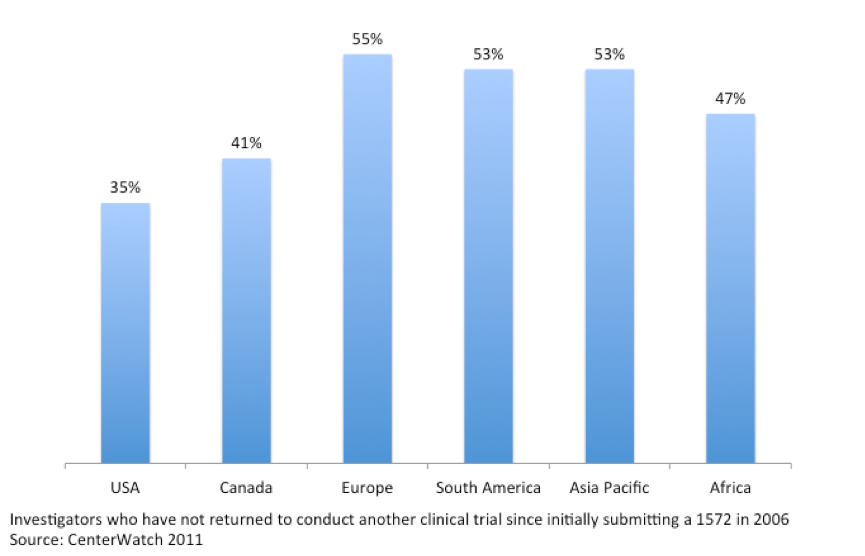
In parallel to pursuing strategies for attracting and training new investigators to clinical research, it is also vital to obtain a better understanding of why investigators stop doing research after only one clinical trial, and to explore options for addressing these issues. A review of the literature suggests that barriers may be system or organization-related as well as trial and physician-related.1,4,5 System and organization-related barriers include time involvement (e.g., research-related work, discussions with patients, grant applications and ethics submissions) and resource issues (e.g., costs involved in research participation, facilities and infrastructure, and requirements of sponsors).1 Trial-related barriers include lack of clinical or scientific rationale for the research, increasing complexity of trials, excessive trial costs not covered by the trial sponsor, and inferior trial medications compared to standard therapy. Physician-related barriers include lack of interest in the research topic, limited familiarity with research procedures, lack of allied support staff, and disruption to clinical practice.
While some of these barriers are immovable (e.g., ethics submissions), many of the system, organization, and physician-related barriers are under the control of the research sponsor and its contract research organization (CRO) partners. In order to help the industry identify solutions to decrease the high investigator turnover rates, we conducted a global survey to solicit actionable feedback from investigators on the burden associated with participating in clinical trials.
Methods: Global survey of 750 investigators
To better understand the burden placed on investigators by clinical operations and the potential value of supporting solutions, DrugDev surveyed 750 clinical trial investigators from its Global Network in seven countries (Argentina, Australia, Germany, India, South Africa, the UK, and the U.S.). An invitation to participate in the 25-question online survey was emailed to approximately 11,000 randomly selected investigators. The survey was open from Oct. 28 to Dec. 3, 2013. Respondents were offered the chance to win one of five iPads.
Respondents rated the questions on investigator burden and supporting solution value on a five-point Likert scale: extremely burdensome/valuable; very burdensome/valuable; somewhat burdensome/valuable; a little burdensome/valuable; and not at all burdensome/valuable. Questions were scored based on the sum of the top two categories: extremely and very burdensome/valuable.
We examined the data for variation by country of origin using the Cochran Mantel-Haenszel statistic for categorical ordinal variables. The U.S. was used as the reference country. In addition, we looked for variation based on previous research experience as measured by the investigator-reported number of previous studies (two or fewer studies, three to 10 studies, and more than 10 studies), also using the Cochran Mantel-Haenszel statistic, with investigators who had conducted more than 10 studies as the reference group.
Results: Sample characteristics
The target sample for this group was 750 completed responses, weighted to the U.S. to reflect global investigator distribution.3 Emails were sent out to achieve the sample size, and as soon as these targets were achieved the survey was closed. Anyone responding after that time was not included in the analysis. A total of 750 investigators responded, with nearly half (45.9%) of the total responses coming from the U.S. An overall response rate of 7% was achieved (750/11,000), ranging from a low of 4% for Germany to a high of 14% for Argentina (see Table 1).
Table 1: Sample Characteristics
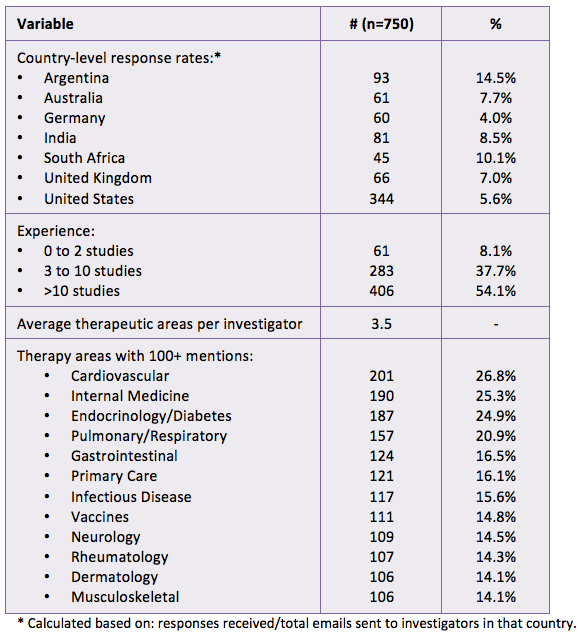
As seen in Table 1, 8.1% of respondents reported that they had participated in two or fewer trials, 37.7% participated in three to 10 trials, and 54.1% participated in more than 10 trials. Most reported having experience in more than one therapy area (an average of 3.5 per investigator), including cardiovascular (26.8%), internal medicine (25.3%), endocrinology/diabetes (24.9%), and pulmonary/respiratory (20.9%).
Results: Investigator reported burden
As shown in Figure 2, completing contractual and regulatory documents was the most burdensome administrative activity for investigators (46% rated this as very or extremely burdensome), with getting paid on time rated as the second most burdensome issue (36% found this issue very or extremely burdensome). Other factors identified as very or extremely burdensome included recruiting patients (32%), budgeting for clinical trials (32%), completing feasibility surveys (31%), and reporting serious adverse events (SAEs, 30%).
Figure 2: Level of Burden Associated with Clinical Trial Operations
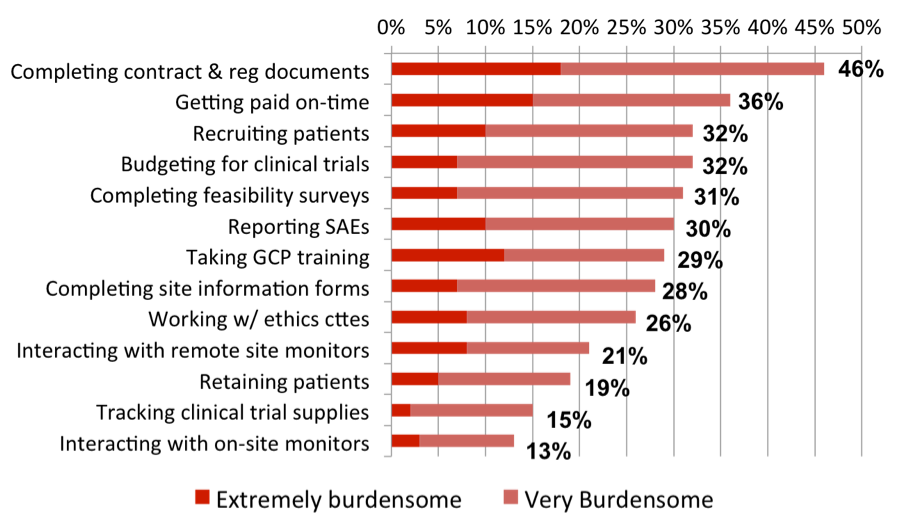
Table 2 summarizes differences seen at the country level and by experience level. There was significant variation by country in six of the factors, with the largest differences seen between investigators in Argentina and the U.S.: reporting SAEs, completing site information forms, working with ethics committees, interacting with remote site monitors, and tracking clinical trial supplies. With the exception of patient recruitment, investigators in other countries rated these factors as being more burdensome than those based in the U.S. For patient recruitment, however, significantly fewer investigators in Argentina (p=0.0008) and India (p=0.0011) found this activity to be extremely burdensome.
Table 2: Variation in Burden Ratings by Country and Experience
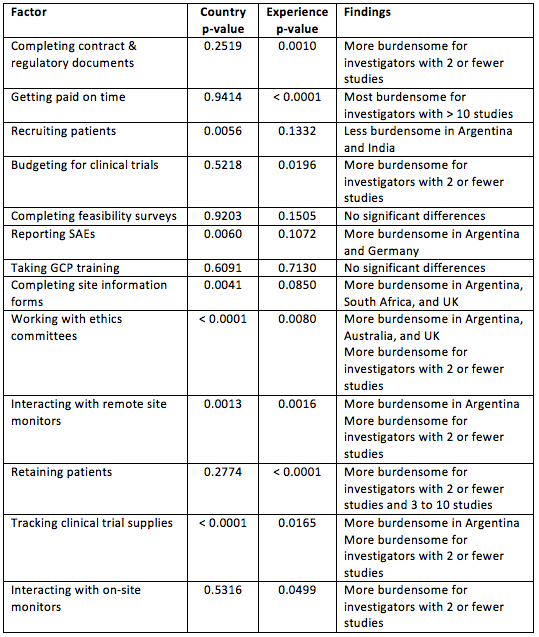
With respect to clinical trial experience, seven items were significantly more burdensome for less experienced investigators who had completed two or fewer studies as compared to the most experienced with more than 10 studies: completing contracts and regulatory documents; budgeting for clinical trials; working with ethics committees; interacting with remote site monitors; retaining patients; tracking clinical supplies; and interacting with on-site monitors. Retaining patients in the study was also significantly more burdensome for investigators with three to 10 studies when compared to the group with more than 10 studies.
In contrast, one item, getting paid on time, was rated as more burdensome by experienced investigators, with 44% of those who had completed more than 10 studies finding this extremely or very burdensome, compared with only 16% of those who had completed zero to two studies.
Results: Value of supportive solutions
When asked what support functions would be helpful, more than 70% of global investigators indicated that the following five approaches would be extremely or very valuable (see Figure 3):
- Completing good clinical practice (GCP) training once every two years only, and uploading the training certificate to a central website accessible to multiple study sponsors (85%)
- Uploading CVs to a central website accessible by multiple sponsors, reducing document collection on study start-up (79%)
- Guaranteed investigator payment within 30 days (78%)
- Annual Master Service Agreement (MSA) with cross-pharma repository of essential documents (75%)
- Cross-sponsor sharing of contractual preferences (73%)
Figure 3: Value of Supporting Solutions
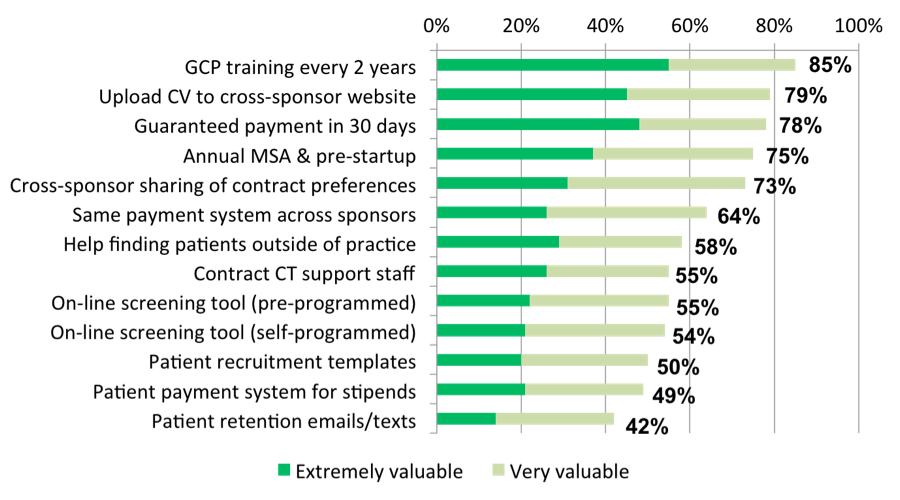
Table 3 shows that there are two primary areas of variation at the country level: patient recruitment and patient retention. Both of these were rated as less valuable among respondents in several countries when compared to those in the U.S. In addition, access to contract clinical trial support staff was viewed as being significantly more valuable in Argentina, Australia, India, and the UK.
Table 3: Variation in Value Ratings by Country and Experience
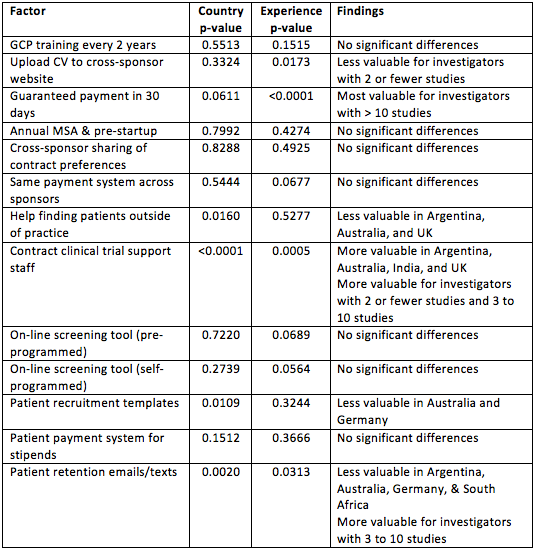
The value of activities associated with clinical trial support also showed some variability based on the level of investigator experience (Table 3). In particular, there was a statistically significant difference between investigators who had carried out zero to two studies compared to those with 10 studies for the response of guaranteed payment within 30 days. Investigators with zero to two clinical studies placed less value on this factor, with 67% of investigators rating this very or extremely valuable, compared to 83% of investigators who have completed more than 10 studies.
In addition to guaranteed payment within 30 days, more experienced investigators (both three to 10 and more than 10 studies) also rated the ability to upload their CV to a cross-sponsor website as significantly more valuable than less experienced investigators. In contrast, access to contract clinical trial support staff was rated as more valuable by investigators with fewer than two and three to 10 studies. Provision of patient retention emails/texts was rated as more important by investigators with three to 10 studies as compared to zero to two or more than 10 trials.
Limitations
Although these findings have important implications for how to decrease the burden of clinical trial operations, the study does have some limitations. First, the study was conducted among a sample of investigators who are members of the DrugDev Network and it is possible that the characteristics of the population could have influenced the results. For example, enrollment in DrugDev may self-select for investigators who are more comfortable accessing and sharing information online. However, given that online and mobile communications are standard practice today (86% of clinicians now report use of smartphones in their professional activities6), it is unlikely that this had a significant impact on results.
While the response rate seen in this survey was similar to those reported for online surveys in other publications,7 another limitation of the study design is the potential for non-response bias. Despite the fact that the proportion of non-responders was high in this study, the results are consistent with comments made by industry experts who have suggested study start-up and ethics as large sources of burden for investigators as well as a trend towards higher protocol complexity posing challenges to patient recruitment.
An additional limitation to this survey is that the investigators could only answer the questions put in front of them, and, therefore, were commenting on the burdens and solutions presented as options. To address this limitation, we also included open-ended questions in both the burden and solution section of the survey to try to identify issues that were not highlighted in the survey. Post-survey analyses of these open-ended questions did not identify any additional factors that were consistently raised by investigators.
Finally, while there was no significant difference in level of experience of investigators across all countries, there were differences between the U.S. and Argentina and India. In both cases, the U.S. had a greater proportion of investigators with more than 10 studies (58% for the U.S. as compared to 40% in Argentina and 37% in India), driven primarily by differences in the three to 10 vs. more than 10 study groups.
Discussion
According to analyses conducted by CenterWatch, the Tufts Center for the Study of Drug Development, and others using FDA 1572 data, the investigator landscape has shifted in ways that challenge successful conduct of clinical trials (e.g., lower proportion of experienced sites; high turnover among new PIs). The resulting impact for sponsors is higher operational costs, especially related to site identification, qualification, and start-up.
The purpose of this investigator survey was to better understand sources of investigator burden in clinical trial operations and to determine the value to investigators of potentially supportive solutions. Although the literature on investigator burden in clinical trials is limited, our findings appear to be consistent with expert comments.
As described above, completing contractual and regulatory documents was the most burdensome administrative activity for investigators, followed by getting paid on time. The level of burden for these two top-rated factors did not show significant variation at the country level. We did observe some variation in level of burden at the country level across six of the 13 factors tested, especially in Argentina. In general, nearly all of the differences were in system/organization-related factors and five of the six were rated as more burdensome outside of the U.S.
The one area of exception was patient recruitment, which was rated as significantly less burdensome in Argentina and India as compared to the U.S. We hypothesize that this finding may be related to differences in physician/patient relationships and access to medical care between countries. In Argentina, for example, the large concentration of population in the cities combined with a low rate of mobility encourages close relationships between patients and investigators, who can quickly identify appropriate patients from their practice and encourage them to learn more about clinical trials.8 The low barrier related to recruitment in India, however, may be more related to access, whereby patients enrolled in clinical trials are able to access free medical care, tests, and drugs, which they could potentially not afford otherwise.
As one might predict, there was a higher perceived level of burden for a number of activities reported by less experienced investigators compared to more experienced investigators, with seven of the 13 factors being reported as more burdensome by those having done zero to two studies compared to more than 10 studies. Again, the majority of these were system/organization related factors, where institutions, sponsors, or CROs could provide more support and resources to those early in their clinical research careers. An example of an area where provision of additional support to less experienced investigators could have a significant impact on start-up time, recruitment metrics, and ultimately investigator turnover is completion of contracts and regulatory documents.
Interestingly, getting paid on time was more burdensome to the most experienced investigators, compared to their less experienced colleagues. This, we believe, reflects the fact that investigators in the more than 10 studies category are more likely to rely on the revenue stream gained from payment from industry-sponsored studies for their business
Understanding the feedback on sources of burden, it is not surprising that the supportive activities that offered the most value to investigators were items that either guaranteed payment, or streamlined start-up such as GCP training, contracting, and essential document collection. Although there is no benchmark with which to compare, the level of value assigned to these activities was high in absolute terms (rated by more than 70% of the sample as extremely or very valuable).
Although this survey is among the first to quantitatively document the value of solutions to reduce investigator burden, including variation by country and level of experience, the findings are consistent with the opinion of industry experts.
Recognizing that system/organizational factors may be outside of the control of the research sponsor, several individual companies and industry organizations have begun to implement solutions to address trial-related sources of investigator burden. For example, TransCelerate BioPharma Inc., a non-profit organization of around 20 biopharmaceutical companies aimed at implementing innovation in clinical research, has created standards for minimum requirements for GCP training, CVs, and site qualification forms amongst other items.9 In addition, organizations such as the Investigator Databank—a global collaboration between Janssen, Eli Lilly, Merck, Pfizer, and Novartis—have launched online profiles where investigators can post non-protocol specific documents (e.g., CVs, GCP training certificates, site qualification forms) just once and have them accessed by all participating sponsors.10 A global network of research sites is also being established by the Alliance for Clinical Research Excellence and Safety (ACRES), with the aim of connecting research sites worldwide through a shared technology platform.11 The Global Health Network provides a number of different resources to support clinical trial conduct, including a Site Finder network, mostly centred on sites in Africa, Asia, and Latin America. The Society for Clinical Research Sites (SCRS) is a trade association established to represent global clinical research sites, and to support site sustainability.
In addition, a number of organizations are working to improve investigator training and accreditation, amongst them the Harvard Multi-Regional Clinical Trials Center (MCRT), the Association of Clinical Research Professionals (ACRP), and ACRES.
Moving beyond these initiatives for setting standards and sharing documents, additional opportunities for mutual benefit exist through standardizing confidential disclosure agreements (CDAs) and clinical trial agreement (CTA) clauses where possible; sharing of contractual preferences at the institutional level; and guaranteeing payment within 30 days.
Ultimately, if we are to reverse the trends of declining physician participation and high turnover in industry-sponsored clinical research, pharmaceutical company research sponsors (and their CRO partners) must be willing and able to change their processes to decrease the burden for clinical trial investigators.
Elisa Cascade, MBA, is Vice President, Corporate Development, DrugDev.org,[email protected]; Claire Sears, PhD, is Project and Communications Director, Drug Dev.org, [email protected];Mark Nixon, PhD, is Director, Biostatistics, Chilli Consultancy, [email protected]
References
- S. Rahman et al. “Physician participation in clinical research and trials: Issues and approaches.” Advances in Medical Education and Practice 2011:2 85–93. http://www.academia.edu/914386/Physician_participation_in_clinical_research_and_trials_issues_and_approaches
- S. Redfearn. CenterWatch: “New data show number of principal investigators dropping 11% globally, and 20% in U.S.” April 25, 2011. http://www.centerwatch.com/news-online/article/1471/new-data-show-number-of-principal-investigators-dropping-11-globally-and-20-in-us#sthash.oLg4K7z5.dpbs
- K. Getz. “Characterizing the Global Investigative Site Landscape.” Presentation at the Drug Information Association 50th Annual Meeting (San Diego, June 15-19, 2014)
- Institute of Medicine (U.S.) Forum on Drug Discovery, Development, and Translation. Transforming Clinical Research in the United States: Challenges and Opportunities: Workshop Summary. Washington (DC): National Academies Press (US); 2010. 3, Challenges in Clinical Research. Available from: http://www.ncbi.nlm.nih.gov/books/NBK50888/
- E Sumi, T Morayama, M Yokode. A survey of attitudes toward clinical research among physicians at Kyoto University Hospital. BMC Medical Education 2009, 9:75 doi:10.1186/1472-6920-9-75. http://www.biomedcentral.com/1472-6920/9/75
- Epocrates 2013 Mobile Trends Report: “Maximizing Multi-Screen Engagement Among Clinicians.”
- A Scott et al.: “A randomized trial and economic evaluation of the effect of response mode on response rate, response bias, and item non-response in a survey of doctors.” BMC Medical Research Methodology 2011, 11:126; doi:10.1186/1471-2288-11-126; http://www.biomedcentral.com/1471-2288/11/126
- L White, Z Ortiz, LG Cuervo, L Reveiz. “Clinical trial regulation in Argentina: overview and analysis of regulatory framework, use of existing tools, and researchers’ perspectives to identify potential barriers.” Rev Panam Salud Publica. 2011;30(5):445–52.
- Press release: TransCelerate BioPharma Inc. Launches Second Year Initiatives, Expands Membership and Achieves Milestones for Original Projects, November 7, 2013. http://www.prnewswire.com/news-releases/transcelerate-biopharma-inc-launches-second-year-initiatives-expands-membership-and-achieves-milestones-for-original-projects-230978611.html
- Investigator Databank press release: Global Investigator Databank Expands to Five Pharmaceutical Company Members and Announces New Investigator Website, May 27, 2014. http://www.drugdev.org/wp-content/uploads/2014/06/DrugDev-Press-Release-22-May3.pdf
- Alliance for Clinical Research and Excellence Press Release: ACRES launches global clinical research network technology platform http://www.acresglobal.net/acres-launches-global-clinical-research-network-technology-platform/
Improving Relationships and Diversifying the Site Selection Process
April 17th 2025In this episode of the Applied Clinical Trials Podcast, Liz Beatty, co-founder and chief strategy officer, Inato, discusses a number of topics around site engagement including community-based sites, the role of technology in improving site/sponsor relationships, how increased operational costs are impacting the industry, and more.
Behind the Buzz: Why Clinical Research Leaders Flock to SCOPE Summit
February 7th 2025In this episode, we meet with Micah Lieberman, Executive Conference Director for SCOPE Summit (Summit for Clinical Ops Executives) at Cambridge Innovation Institute. We will dive deep into the critical role of collaboration within the clinical research ecosystem. How do we bring together diverse stakeholders—sponsors, CROs, clinical trial tech innovators, suppliers, patients, sites, advocacy organizations, investors, and non-profits—to share best practices in trial design, program planning, innovation, and clinical operations? We’ll explore why it’s vital for thought leaders to step beyond their own organizations and learn from others, exchanging ideas that drive advancements in clinical research. Additionally, we’ll discuss the pivotal role of scientific conferences like SCOPE Summit in fostering these essential connections and collaborations, helping shape the future of clinical trials. Join us as we uncover how collective wisdom and cross-industry partnerships are transforming the landscape of clinical research.